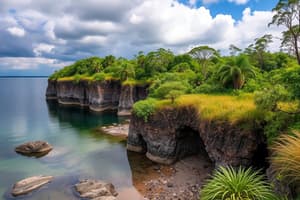Podcast
Questions and Answers
What does in situ conservation primarily focus on?
What does in situ conservation primarily focus on?
- Restoration of habitats for species
- Conservation of species outside their natural habitats
- Genetic variability within species in their natural surroundings (correct)
- Captive breeding of endangered species
Which of the following is NOT an example of ex situ conservation strategies?
Which of the following is NOT an example of ex situ conservation strategies?
- Natural habitat restoration projects (correct)
- Turtle sanctuaries for marine turtles
- Seed genebanks for rice and vegetables
- Captive breeding centres for Sumatran rhinoceros
Which type of ecosystem service refers to products obtained directly from ecosystems?
Which type of ecosystem service refers to products obtained directly from ecosystems?
- Cultural services
- Supporting services
- Regulating services
- Provisioning services (correct)
What is a major benefit of ex situ conservation?
What is a major benefit of ex situ conservation?
Which of the following correctly describes in situ conservation?
Which of the following correctly describes in situ conservation?
What is one of the roles of cultural ecosystem services?
What is one of the roles of cultural ecosystem services?
What is the focus of the National Policy on Biological Diversity 2022-2030?
What is the focus of the National Policy on Biological Diversity 2022-2030?
Which of the following is an example of in situ conservation?
Which of the following is an example of in situ conservation?
Flashcards
Ecosystem Services
Ecosystem Services
Benefits obtained from nature that directly contribute to human well-being.
In Situ Conservation
In Situ Conservation
The use of natural ecosystems and habitats to conserve species in their natural environment.
Ex Situ Conservation
Ex Situ Conservation
Protecting species outside their natural habitat, using methods like zoos, seed banks, or botanical gardens.
Arboreta & Field Gene Banks
Arboreta & Field Gene Banks
Signup and view all the flashcards
Seed Gene Banks
Seed Gene Banks
Signup and view all the flashcards
Captive Breeding Centres
Captive Breeding Centres
Signup and view all the flashcards
Rehabilitation Centres
Rehabilitation Centres
Signup and view all the flashcards
National Policy on Biological Diversity
National Policy on Biological Diversity
Signup and view all the flashcards
Study Notes
Overview of Biodiversity
- This topic covers the values of biodiversity, current threats, and efforts to sustain biodiversity.
Values of Biodiversity
- Biodiversity supports various ecosystem services:
- Provisioning: Products obtained from ecosystems (e.g., food, timber).
- Regulating: Benefits from regulating services (e.g., climate regulation, pollination).
- Cultural: Non-material benefits (e.g., aesthetic value, spiritual significance).
- Supporting: Services necessary for the production of other ecosystem services.
In Situ Conservation
-
Involves conserving ecosystems and natural habitats, maintaining viable populations of species in their natural surroundings, and covering genetic variability.
-
Aims to preserve species and ecosystems in their natural habitats.
-
Includes conservation, management, and rehabilitation of habitats.
-
Focuses on selected/target individual species in natural habitats/ecosystems through conservation or management.
Ex Situ Conservation Strategies
- Involves the conservation of biological diversity components (seed, clone, live saplings, pollen, or DNA) outside their natural habitat.
- This makes it easier for scientists to access, study, distribute, and use plant resources.
- Examples of ex situ conservation strategies in Malaysia include arboreta, field gene banks, seed gene banks, captive breeding centres, rehabilitation centres, and turtle sanctuaries.
Challenges to Plant Conservation
- Key challenges include land development, pollution, poaching, climate change, and invasive alien species.
Biggest Threats to Biodiversity
- Climate Change: Increased global temperatures impacting seasons, sea levels, and glaciers.
- Habitat Loss & Degradation: Habitat loss from natural events (e.g., natural calamities, geological events) or human activities (e.g., deforestation, man-induced climate change).
- Pollution: Water, air, and land pollution threaten all life forms.
- Invasive Species: Introduced species negatively impacting native species.
- Overexploitation: Over-harvesting species at rates exceeding their natural capacity to sustain themselves.
- Other Potential Threats: Epidemics and infectious diseases in wildlife.
Law and Regulations
- Strict laws and regulations exist regarding protected plants and wildlife in Sarawak (Malaysia).
- Penalties for illegal acts include fines and imprisonment.
- Penalties vary depending on the type of protected plant/animal.
- Reporting violations and seeking clarifications are possible channels.
National Policy on Biological Diversity (2022-2030)
- Policy statement emphasizes the conservation and sustainable use of biological diversity in Malaysia.
- This includes the fair and equitable sharing of benefits from resource use.
- Five key goals are established:
- Goal 1: Empower and engage stakeholders in biodiversity conservation
- Goal 2: Reduce direct and indirect pressures on biodiversity
- Goal 3: Safeguard key ecosystems, species, and genetic diversity
- Goal 4: Safely use biodiversity and equitably share benefits
- Goal 5: Improve capacity, knowledge, and skills for biodiversity conservation
National Action Plan on Invasive Alien Species (2021-2025)
- Aims to improve understanding and public awareness of invasive alien species (IAS).
- Conduct risk assessment of introduced exotic species before release.
- Strengthen quarantine inspection and enforcement at entry points and international borders.
Studying That Suits You
Use AI to generate personalized quizzes and flashcards to suit your learning preferences.




